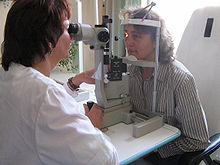Watzke–Allen test
| Watzke-Allen test | |
|---|---|
 A macular hole | |
| Purpose | diagnosis of full thickness macular hole |
Watzke-Allen test (WAT) also known as Watzke-Allen slit beam test (WASBT) is a test used in the diagnosis of a macular hole, a condition affecting the macular region in the retina of the eye. The test is done by projecting a thin line of light over the macula with a slit lamp.
Theory
Watzke-Allen test is a test used in the diagnosis of a macular hole. It is a subjective test based on photoreceptor (cone cell) displacement.[1]
Test can be used to differentiate full thickness macular hole from other similar conditions and also to assess retinal function after surgical closure of the hole.[2][3]
Procedure

Watzke-Allen test is done by projecting a thin line of light over the macula with a slit lamp.[4] A fundus lens or macular lens is used to aim beam of light on the macula.[5] It is best performed in a dilated eye, projecting a slit beam of approximately 100µm. The slit is projected in both vertical and horizontal orientations.[6] The patient is asked to describe whether the light line is straight or narrow or has a gap (break). A straight line indicates an intact fovea where as narrow or gapped line indicate macular holes.[7] A narrowing indicates isolated, damaged but functional foveal receptors.[7] Patient may be asked to draw what he sees.[6]
Advantages and disadvantages
The advantages of WAT are its availability, affordability, easy to perform and ability to be used through relatively opaque media, which can help overcome the limitations of spectral-domain OCT, however, it is not known whether the measurements recorded by WAT reflect the true extent of photoreceptor displacement.[6][1]
References
- ^ a b Mizuguchi, Tadashi; Horiguchi, Masayuki; Tanikawa, Atsuhiro; Sakurai, Ryouta (2021-09-01). "Asymmetric extent of distortion measured using the Watzke-Allen Test in patients with macular hole". Heliyon. 7 (9): e08059. doi:10.1016/j.heliyon.2021.e08059. ISSN 2405-8440. PMC 8488488. PMID 34632139.
- ^ "MORE SENSITIVE LINE TEST AS ALTERNATIVE TO WATZKE–ALLEN SLIT– BEAM IN PATIENTS AFTER ANATOMICALLY SUCCESSFUL CLOSURE OF IDIOPATHIC MACULAR HOLE". Investigative Ophthalmology & Visual Science. 45. May 2004. Archived from the original on 2023-02-19. Retrieved 2023-02-19.
- ^ Veiga-Reis, Francyne; Dias, Renato Braz; Nehemy, Márcio B. (December 1997). "Differential diagnosis of macular hole: Watzke-Allen test and laser aiming beam test". Arquivos Brasileiros de Oftalmologia. 60 (6): 631–634. doi:10.5935/0004-2749.19970012. ISSN 0004-2749.
- ^ "Watzke-Allen sign". Oxford Reference. Archived from the original on 2023-02-22. Retrieved 2023-02-19.
- ^ Maharana, Prafulla Kumar; Sharma, Namrata; Kumar, Atul (2017-09-30). Ophthalmology Clinics for Postgraduates. JP Medical Ltd. ISBN 978-93-86322-89-0. Archived from the original on 2023-11-07. Retrieved 2023-02-22.
- ^ a b c MPH, By Juan Canizales, OD, and Christopher Suhr, OD. "Macula Exam Tips and Tricks". www.reviewofoptometry.com. Archived from the original on 2023-02-19. Retrieved 2023-02-19.
{{cite web}}: CS1 maint: multiple names: authors list (link) - ^ a b Themes, U. F. O. (2016-11-05). "Macular Hole". Ento Key. Archived from the original on 2023-02-19. Retrieved 2023-02-19.